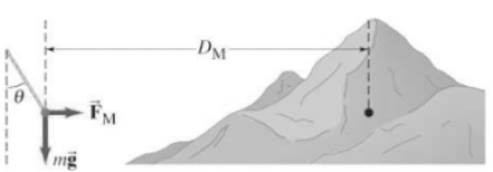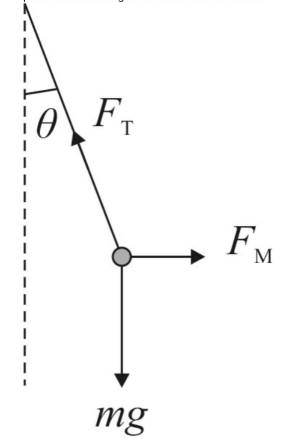
Concept explainers
(a)
The approximation formula for
(a)
Answer to Problem 75GP
The approximation formula for
Explanation of Solution
Given:
The given figure is shown below.

Formula used:
The gravitational force of attraction is
Calculation:
Consider the free body diagram of plumb bob, whose mass is m , as shown below.

Here,
The gravitational force of attraction between plumb bob and mountain is given as,
Here, m is the mass of bob, mm is mountain mass and
It is given that bob is not accelerating, so the net force in horizontal as well as vertical direction will be zero.
In vertical direction net force is,
In horizontal direction, net force is
The expression for g at Earth’s surface is,
Substituting the value in equation (2)
From (1) and (3),
Conclusion:
Therefore, the approximation formula for
(b)
The mass of Mt. Everest.
(b)
Answer to Problem 75GP
The mass of Mt. Everest is
Explanation of Solution
Given:
The given figure is shown below.

The shape of Mt Everest is cone whose base diameter is 4000 m and height is 4000 m. Density or mass per unit volume is 3000 kg per m3.
Formula used:
The mass is given by,
Calculation:
If Mt Everest shape is cone, then is volume is given as,
So, mass of Mt Everest will be,
Substituting the values,
Conclusion:
Therefore, the mass of Mt. Everest is
(c)
The angle
(c)
Answer to Problem 75GP
The angle
Explanation of Solution
Given:
The given figure is shown below.

Distance of bob from center of Mt Everest is 5 km.
The shape of Mt Everest is cone whose base diameter is 4000 m and height is 4000 m. Density or mass per unit volume is 3000 kg per m3.
Formula used:
From part (a), the angle
Calculation:
From part (b), mass of Mt. Everest is
The value of
Conclusion:
Therefore, the angle
Chapter 5 Solutions
Physics: Principles with Applications
Additional Science Textbook Solutions
Conceptual Integrated Science
The Cosmic Perspective Fundamentals (2nd Edition)
Conceptual Physical Science (6th Edition)
An Introduction to Thermal Physics
University Physics (14th Edition)
Essential University Physics (3rd Edition)
 College PhysicsPhysicsISBN:9781305952300Author:Raymond A. Serway, Chris VuillePublisher:Cengage Learning
College PhysicsPhysicsISBN:9781305952300Author:Raymond A. Serway, Chris VuillePublisher:Cengage Learning University Physics (14th Edition)PhysicsISBN:9780133969290Author:Hugh D. Young, Roger A. FreedmanPublisher:PEARSON
University Physics (14th Edition)PhysicsISBN:9780133969290Author:Hugh D. Young, Roger A. FreedmanPublisher:PEARSON Introduction To Quantum MechanicsPhysicsISBN:9781107189638Author:Griffiths, David J., Schroeter, Darrell F.Publisher:Cambridge University Press
Introduction To Quantum MechanicsPhysicsISBN:9781107189638Author:Griffiths, David J., Schroeter, Darrell F.Publisher:Cambridge University Press Physics for Scientists and EngineersPhysicsISBN:9781337553278Author:Raymond A. Serway, John W. JewettPublisher:Cengage Learning
Physics for Scientists and EngineersPhysicsISBN:9781337553278Author:Raymond A. Serway, John W. JewettPublisher:Cengage Learning Lecture- Tutorials for Introductory AstronomyPhysicsISBN:9780321820464Author:Edward E. Prather, Tim P. Slater, Jeff P. Adams, Gina BrissendenPublisher:Addison-Wesley
Lecture- Tutorials for Introductory AstronomyPhysicsISBN:9780321820464Author:Edward E. Prather, Tim P. Slater, Jeff P. Adams, Gina BrissendenPublisher:Addison-Wesley College Physics: A Strategic Approach (4th Editio...PhysicsISBN:9780134609034Author:Randall D. Knight (Professor Emeritus), Brian Jones, Stuart FieldPublisher:PEARSON
College Physics: A Strategic Approach (4th Editio...PhysicsISBN:9780134609034Author:Randall D. Knight (Professor Emeritus), Brian Jones, Stuart FieldPublisher:PEARSON





